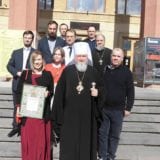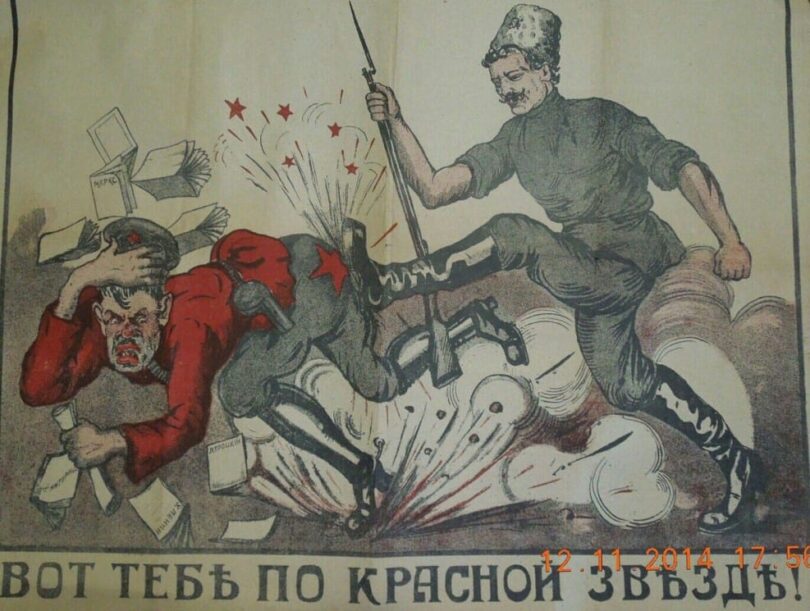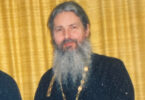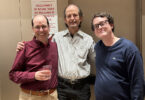From ROCOR Studies
In the span of less than half a year, the field of the modern history of the Russian Church, which does not exactly suffer from a surplus of experts, lost two eminent figures, Dimitry P. Anashkin and Vladimir S. Rusak. Against this sad backdrop, the following interview with Yulia Aleksandrova Biriukova, Assistant Professor of Don State Technical University (Rostov-on-Don) and Senior Instructor at Saint Tikhon’s Orthodox University of the Humanities (Moscow), inspires hope.
May of this year marks the centenary of the Southern Russian Church Council, which was held in Stavropol, at that time under the control of General Denikin’s Armed Forces of South Russia. This Council of 1919 has a profound significance for the Russian Orthodox Church Abroad, since it served as an intermediary link between the All-Russian Local Church Council of 1917-18 and the First Pan-Diaspora Council of 1921, with many of its members eventually emigrating. It is interesting that the South-Eastern Council demonstrated a high degree of responsibility with respect to political pronouncements, which was not the case within the émigré milieu of Russian Church, where such statements were often made on behalf of the Russian Church. Various mention is made of the Council in émigré publications. Among others, Eksakustodion Makharoblidze mentions the approval given to the Council’s resolutions by Patriarch Tikhon, which allows us to reach a conclusion about attempts to form groupings of dioceses in areas controlled by anti-Communists at the time Ukaz No. 362 of November 7/20, 1920, was issued by Patriarch Tikhon, the Holy Synod, and the Supreme Church Council. Iulia Biriukova’s monograph, published by Novospassky Monastery in 2018, is a pathbreaking work.[1]Iugo-Vostochnyi Russkii Tserkovnyi Sobor 1919 goda, sbornik dokumentov [The South-Eastern Council of the Russian Church of 1919: Collected Documents. Edited by Iu. A. Biriukova.] Moscow: … Continue reading This anthology contains all the documents that could be obtained concerning the сouncil’s work, including materials from the period of preparation for the сouncil, from plenary sessions, and from periodical publications that give a sense of the spirit of the times and of contemporary responses to the сouncil. Here we present an interview with the distinguished author of this work, who is a specialist in the history of the Russian Church in Southern Russia during the Revolution, Civil War, and the pre-War era. This translation has been made possible by a grant from the American Russian Aid Association – Otrada, Inc.
Yulia Aleksandrovna, thank you very much for finding time to talk to our readers. I am glad that our contacts, which began with your interview and article about the Southern Russian Council, are being continued through our site. The Council of 1919, as far as I understand, was little known up until now. In the past, émigré Church historians, for example, Fr. Mikhail Polskii (in his work Kanonicheskoe polozhenie Russkoi Tserkvi na rodine i zarubezhom [The Canonical Situation of the Russian Church in the Homeland and Abroad]), had written about it. Now, however, few of us outside of Russia remember it. In May of this year, the Stavropol Diocese of the Russian Orthodox Church was holding a special conference dedicated to the Council, that is to say that interest in it is increasing. And you, so it happens, are the leading expert on this Council today, isn’t that right?

Y.A. Birukova is with a certificate of distinction from Metrop. Kirill of Stavropol following the conference there. May. 13.
Well, yes, perhaps – I won’t refuse the title if you’ve decided to give it to me! It must be said, of course, that this collection of documents and materials from the Council that has come out, as well as the major upcoming conference and celebrations in Stavropol, speak to the fact that real, deliberate attention is nonetheless being paid to the Council. Needless to say, this was not the case up until now, even though its legacy was well known from relatively early on, beginning in the 1930s, when the famous anti-religious leader Boris Pavlovoich Kandidov began to focus on the council’s work. He, of course, was studying this work with reference to his own anti-religious motivations. In our own time, it is historians who have turned to study the work of the Council. One might note two publications by Fr. Nikolai Kriachko and articles by Andrei Alexandrovich Kostriukov. A range of other authors have mentioned it. It must be said that this is not sufficient. That is, we more or less know about its legacy, but there has not been sufficient attention paid to it and interest in it. It has not come to be perceived as a significant historical event. And the complete set of documents from the Council has never been published, systematized, studied historiographically, supplied with a critical apparatus, and, most important of all, presented in the context of their era, of that time. In all likelihood, the legacy of the Council has never been studied in this way.
Yulia Aleksandrovna, perhaps we can go on a digression here, since we’re talking about the context of the era in which the Council of Stavropol took place, and look at whether it could be considered almost as an extended session of the Council of 1917-18. Please correct me if I am mistaken.
In essence, yes: I agree with you. The truth is that I am not the first person to think about it in this way. In saying this, I am referring to the conception that prevailed in 1919. Namely, contemporaries of the council regarded it as nothing other than a continuation of the All-Russian Local Church Council, which, as they firmly believed, had been interrupted but not terminated. That is, they had hoped that at some point, communications with the Patriarch, Supreme Church Council, and Holy Synod might be restored and that the All-Russian Local Council, which had been dispersed by the Bolsheviks, might be able to continue its work. People had a belief in this. They hoped that the troubles were temporary, that they would cease and everything would go back to the way it was before. Accordingly, in the areas that were not yet subject to the Soviet authorities, there was a need to keep living as before, to keep building up Church life. The most interesting thing is that it was precisely during this difficult time, during the Civil War, that the South-Eastern Council was convened in the southern Russian dioceses to deal mainly with purely ecclesiastical issues. Of course, it made a series of appeals in which one might perceive a political stance, but I would say that this was not its main task, but rather a sideline. Its main aim was to organize church life in the southern dioceses, which were in areas under the control of General Denikin’s forces and benefited from freedom and independence. And we know what was going on in the areas that were already controlled by the Bolsheviks.
Iulia Alexandrovna, I always tell my students that the Russian Orthodox Church Abroad basically emerged after the front appeared during the Civil War, since there was a total difference in mentality between those who ended up in Moscow and Petrograd and those who were in the territory controlled by the White Army. Did the Council members have any sense that this state of affairs might go on for many years? That the South [of Russia] might become like Taiwan, where Chinese nationalism still prevails? That the South might also be controlled [by the Communists] for many years? Or is there no such feeling that the division might be permanent?
You know, there really was not. One finds only hope that Denikin’s forces might penetrate deep into Russia and reconquer these territories and that the country’s territorial integrity might be restored; that peace might be restored there and the church in the South could be reunited with the Patriarch; that the Temporary Supreme Church Authority would transfer its authority to the Patriarch in its entirety; and that the South-Eastern Council of the Russian Church would restore to the Local Council the powers that it had requisitioned in the special conditions of the time. This is a line of thought that can be clearly discerned. It is possible that later on, in Crimea, there was already a sense that the end was near, but then, at that moment, the Volunteer army still believed it would be victorious.
That makes sense. And on the whole, references to the 1917 Council are frequently found in the materials from the Council of Stavropol, and the number of attendees at it who had also been at the Council of 1917 is significant.
Yes. Of the 59 attendees at the South-Eastern Council, 30 also attended the All-Russian Local Council, that is, half of them, or rather, one more person than half.
Did they have respect for the Council of 1917? Were there not any attempts to revise its decisions, to polemicize with it? To do what people did in the emigration, to try to correct its decisions by, for example, politicizing them? In 1921, the Pan-Diaspora Council practically went against the stance that the Church is apolitical when it approached the Romanovs with a request to restore the dynasty. Were there any such motions at the South-Eastern Council?
You know, such a stance contrasts not only with that of the All-Russian Local Church Council, but also with that of the South-Eastern Council, and with church policy in Southern Russia in general. Of all places, it was there that people were most afraid of making political proclamations or of the Church getting involved in politics. But why was this so? Because the White Army forces were fairly diverse in terms of politics. They included everyone who was against the Bolsheviks, even moderate leftists. How could they possibly be unified? It was probably due to its excessive ideological “promiscuity” that the White Movement did not succeed. That was one of the factors, at least. How was the Church to act in such a situation? First and foremost, one thing and one thing only was clear, which was that the Church was not on the side of the Reds, since, in spiritual terms, they were a completely different kind of force, an opposing force that, as a principle, wanted to wipe the Christian faith off the face of the Earth and to destroy the Church. As far as the other political forces were concerned, the Church understood that it was not her place to make sense of them. That is a matter for the people, a private matter for its members to figure out for themselves. After all, Christ did not support any one political party or another. He did not even exhort the Jews to rebel against Roman rule. And so, following the image of her Teacher, the Church in the South of Russia adopted a completely spiritual stance: not to intervene and disrupt thereby the incredibly fragile balance of power that had been reached, and not to come out in favor of one side or another. Otherwise, the Church would have set herself and her work in opposition to the other sides. In this sense, her position was similar to that of the Volunteer Army’s command; the Church was in agreement with the White government. Another thing to bear in mind is that the Church was very afraid of any politicization of her work and, accordingly, proceeded very carefully. There were many people who hoped to bring her over to their own side. But she adopted a moderate position, reiterating her supra-partisan and apolitical nature. This is reflected in the documentation from the council. In its appeals to various authorities — the Cossacks, the Reds, and so on — it emphasized that the Church’s main concern was the spiritual regeneration of Russia, which was to form the basis of her political and national regrowth. This was the main thing towards which the Church was striving at the time. She was attempting to maintain this stance.
In its appeals to various authorities — the Cossacks, the Reds, and so on — it emphasized that the Church’s main concern was the spiritual regeneration of Russia, which was to form the basis of her political and national regrowth.
There were, of course, politicized individuals to be found amongst the Council members. For instance, the well-known priest Vladimir Vostokov constantly attempted to steer the council towards adopting political resolutions. One detects in Fr. Vladimir a hint of condemnation of the council, the patriarch, and the Church as a whole for this reticence, indeed, for not sufficiently condemning the Revolution, for their not wanting to condemn the whole Soviet system. He expressed this in fairly harsh terms. People raised objections to him: first and foremost, that Patriarch Tikhon was at the time still making ardent proclamations condemning the fratricidal Revolution and the murders of the clergymen, and not about being apolitical. What is more, it was remarked at the Council that this was a veritable feat for the Patriarch, comparable with that of Patriarch Hermogenes, whereas when the members of the South-Eastern Council, who were out of harm’s way, under the protection of the Whites, made similar proclamations, this entailed no such heroism and would not be convincing – not right, even. This settled matters. Vostokov’s proclamations came to be perceived as extremely marginal, and he was even forbidden to speak. Even the Temporary Supreme Church Governance, which was formed later, had a very negative take on him, calling him “a second Heliodorus, only in reverse”, an “inverse Heliodorus” (with reference to his hatred of Grigorii Rasputin).
In other words, it is the case that any references made to the Council of 1917-1918 evince a deep reverence for it?
To say the least! Let’s start with the fact that the South-Eastern Council did not draw up its own regulations. It used those which had governed the work of the All-Russian Local Church Council and always consulted its experience in disputed matters, that is, people tried to find out what the Local Council had done in such instances. Here, therefore, one ought to speak of total assimilation: adoption of all its accomplishments in new conditions. This applies to its establishment of a new supreme church governing body, as well. The South-Eastern Council was also structured by analogy with it; its structure was even copied from it, with adjustments made merely for reasons of scale. This structure consisted in a general assembly and a consultative group of bishops. The right to cast the deciding vote rested not only with bishops, but also with the other clergy and the laity. Yet the group of bishops could also veto any decision, so that the bishops still had the final word. At first, the name “Local” was even adopted, as in, the “South-Eastern Local Council”. Subsequently, however, it was dropped.
Do you happen to remember how many of the members of the Council ended up emigrating?
4 out of 11 bishops emigrated. Of the clergy as a whole, the majority remained. We know for sure that 7 members of the parish clergy at the Council emigrated, though those who did were among its most eminent representatives. Most of those who remained were repressed. Many laypeople also ended up emigrating. Just looking at the Temporary Supreme Church Governance, in the form in which it was elected at the сouncil, most of its members remained within Russia. This is true of all the bishops: Archbishop Mitrophan (Simashkevich), Bishop Arseny (Smolenets), who was subsequently put on trial…
Bishop Dimitry (Abashidze) of Tavria?
Yes. Among the laity, there was Pavel Verkhovsky. As it happens, he remained in Rostov-on-Don and took holy orders from Bishop Arseny, after which point he experienced various hardships. He was repressed on several occasions. He died in exile in 1943. On the other hand, Protopresbyter Georgy Shavelsky, Archpriest Alexander Rozhdestvensky, and Vladimir Musin-Pushkin ultimately emigrated.
Iulia Alexandrovna, here is another issue: the significance of the Council for the Russian Orthodox Church – for the Church nowadays, it is to be understood. Or, indeed, not only nowadays.
First and foremost, there is the preservation of the conciliar principle. I consider this to be the Council’s main significance. The Local Council of 1917-18 brought about the restoration of this principle. This, and not even the election of a patriarch, was its main action. Second, the Council preserved the same approach to resolving ecclesiastical issues. This is important for the Russian Orthodox Church in general and, in my view, remains pertinent today. This is the most essential act of the council that has not lost its relevance even now. Specifically, it meant getting the entirety of the Church involved in resolving issues related to church life, and that the parish clergy and laypeople all could assume not a symbolic but an active role in solving ordinary church-related problems and key ecclesiastical issues. In other words, everything was not to come from the top down, as it did in the Synodal Period, when almost nothing depended on the parishes at the local level. If nothing depends on a person, then it makes no sense for him to do anything – there is no motive for him to be creative. This is inevitably a destructive process. After the February Revolution, a whole wave of active engagement took place on a local level; congresses of clergy and laypeople began to be held. Everyone was able to participate in building up church life and to express opinions freely. One must make note of the huge enthusiasm with which this process was met. It took place during the preparations for the Local Council and at both the Local Council itself and the South-Eastern Council. Such independence and freedom of opinion and such an upsurge of creativity in searching for solutions for pressing ecclesiastical issues mean that this was a very valuable period in the history of the Russian Church.
Now, of course, we must study this legacy in the new conditions in which we live, we must bring to light those things which are particularly valuable and important for us and implement them creatively in accordance with the contemporary situation.
In that it led to a resurgence of involvement in Church life, if we can put it that way.
Yes, one could put it like that, for the process of the Russian people’s drifting away from the Church began long before the Revolution. It was not dreamt up by the Bolsheviks.
Getting the entirety of the Church involved in the life of the Church again and bringing back the conciliar principle were very important in preserving the Church in the conditions of the policy of persecution enacted by the Soviet authorities. It seems to me that a paradigm shift took place, one might say. A change in people’s thinking. The bounds of responsibility for the future of the Church began to expand to include ordinary parishioners. It was thanks to this, perhaps, that the Church survived. Ordinary parishioners, elderly ladies and women created “groups of twenty” [a minimum number of practitioners required by the Soviets to register a community] and fill churches, guarded Church property, and took part in saving the clergy, supporting them in exile and in prison.
Apart from this, one must ascribe importance to the processes of decentralization of ecclesiastical governance and the breaking up of dioceses. This fell within the remit of the Local Council. Such processes of breaking up dioceses were at work earlier, too, but only in a relatively subdued way, whereas the Local Council, of course, spurred this all on. This approach was followed by the South-Eastern Council, and the process continues even to this day.
That is, there was some blueprint, some standard, a bar had been set. Even if the most of the members of the Council ended up living overseas, their actions nonetheless gained a foothold in their native land, despite the fact that information about the Council was lost shortly thereafter.
It was indeed lost, and its relevance died down, since the problem of survival assumed primary importance. But I agree that it had an effect on people’s way of thinking, in that one might say that an idea of how Church life should be organized had been manifested.
It is probably not a coincidence that people have now got talking about the councils’ legacy – I mean that of the Local Council and, within the southern part of Russia, that of the South-Eastern Council. Ecclesiastical consciousness requires us to make sense of this experience and to integrate it. It is sometimes said that the local council was not able to implement anything. Some sessions were held – so what? Nothing was left, nothing at all, nothing was implemented, there wasn’t a chance for it to be implemented. But wasn’t the South-Eastern Council of 1919 an instance of the directives of the Local Council being adopted?
Yes.
And so too was the Temporary Supreme Church Governance of Southern Russia, was it not? In other words, there was continuity. Now, of course, we must study this legacy in the new conditions in which we live, we must bring to light those things which are particularly valuable and important for us and implement them creatively in accordance with the contemporary situation. This is something that lies ahead for the Church – we are only at the beginning of this journey.
Conducted by Deacon Andrei Psarev
References
| ↵1 | Iugo-Vostochnyi Russkii Tserkovnyi Sobor 1919 goda, sbornik dokumentov [The South-Eastern Council of the Russian Church of 1919: Collected Documents. Edited by Iu. A. Biriukova.] Moscow: Novospassky Monastery Publishing House, 2018. |
|---|











